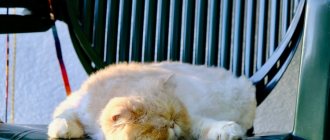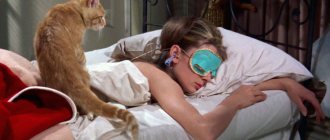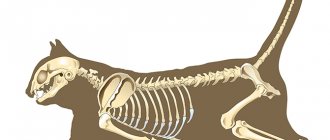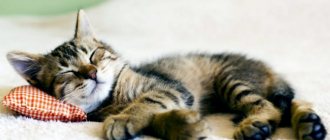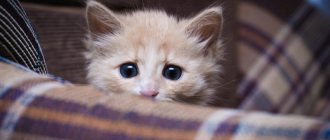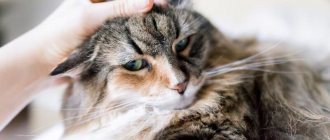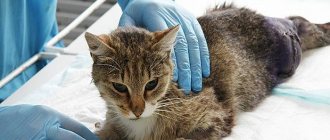4992Pavel
The reason that a cat chases its tail lies in its biology. Felines are hunters and, unlike dogs, can chase their own bodies. The question is how often they do it.
Everyone knows that everything is good in moderation. Therefore, if the owner of a cat notices that she often runs after her tail a lot, it is worth contacting a veterinarian. He will find out why the animal behaves this way and whether it is related to a health problem. The impairments may be physical or mental.
© shutterstock
Tail - simulator
When a young cat, not yet a year old, begins to chase its tail, it learns to hunt small and fast prey. With the help of its tail, it practices movements and techniques useful for hunting.
Before attacking the tail, the kitten wags its tip. This is how he teases himself. Decorative breeds, although they are not hunters, do need intellectual development.
The cat plays and develops useful skills. It’s another matter if the pet is over a year old, but he continues to play with his tail for a long time. Then the reason is related to a health problem.
How cats show their mood
A cat's tail consists of many vertebrae and performs a large number of functions. The main role is balancing during movement and hunting. But a cat's tail is also an expression of her behavior and character. This means that if the owner is attentive and loving, then it will be easy for him to determine the cat’s mood by the tail. It is when and how a cat shakes its tail that you can understand what mood it is in.
A cat's tail twitches in different ways - both vertically and horizontally. To figure out how to understand a cat by its tail, you need to take into account many factors. These may include:
- people unfamiliar and incomprehensible to them. For older cats, this can be a stressful environment. And if this is a cat with kittens, then the trembling tail will immediately let you understand displeasure and fear for its offspring;
- general situation in the breeder’s family. If you constantly scream and at the same time can periodically hit the kitten, you should be prepared for the fact that the cat arches its back and its tail is fluffed or tucked. But when you love and cherish your pet, then his tail will almost always be a pipe, and the threat of an arched back and hissing sounds will bypass you;
- If an animal beats its tail, meows, shakes, its pupils are dilated and it tucks or arches its tail, then the pet is letting you know that it is experiencing fear. In such a situation, it is better to remove the object that provoked panic;
- An unfamiliar environment or moving can also cause displeasure in the pet, which will be expressed in the fact that the cat jerks its fifth limb. Let her know that you are looking out for her and want the best for her.
Needs for development of intelligence
Don't be afraid of pets chasing their tails. Cats are allowed to hunt for parts of their body at a young age. If the game lasts for a long time, you should ask a specialist about possible developmental disorders.
To develop your pet's intelligence, you can invite him to play special games. They will help the animal acquire the skills necessary for hunting. Toys can help your pet.
Types of toys popular among cats:
- feathers attached to a holder;
- bells on a cord;
- beanbag;
- a toy filled with catnip;
- interactive games on a tablet.
© shutterstock
If games do not help and the animal continues to run in circles after its tail, you should think about a mental disorder.
The course of labor in cats
The cat notifies that labor has begun by its behavior: the pet is fussing, breathing heavily, the expectant mother is looking for a secluded corner, and trembling runs through the animal’s body. The birth process in a cat should not last more than a day from the time of the first contractions. Consists of several phases, namely:
Little fluffies are born at the pushing stage.
- Preparation of channels. The cervix dilates up to 12 o'clock.
- Contractions. Smooth muscle muscles contract.
- Attempts. The abdominal muscles are activated.
- The process of giving birth to a kitten. Contractions and attempts alternate, and the fetus comes out.
- Cleansing from afterbirth. After 10-20 minutes. after the babies arrive.
- Contraction of the uterus. Minor bleeding for 1-2 days. after the birth of kittens.
Neurosis
In stressful situations, a cat may try to catch its own tail. If this play is compulsive, a veterinarian may diagnose it as neurological. But this term is very broad. It implies deviations in the functioning of nerve endings.
About 10% of cats chase their own tail due to extreme stress. It can be caused by external stimuli such as the sound of a vacuum cleaner turned on, a buzzing drill, etc.
The specialist must clarify what exactly is wrong with the cat. If he is not specific, it is better to contact another veterinarian.
When to be wary
Running is often accompanied by other symptoms that should alert the owner:
- involuntary clicking of teeth;
- compulsive licking of paws or other parts of the body;
- chewing fur as a way to get rid of fleas, even if there are none;
- the animal eating its own feces;
- uncontrolled aggressive behavior towards household members;
- aggression of males towards females.
The therapy is based on a technique that allows you to find out the root cause of the disorder.
Behavior correction is carried out with the help of a specialist. The environment should be calm, and a trusting relationship must be established with the animal. If your dog starts to feel dizzy during a walk, you should distract him with play. You can’t feel sorry for or console a dog.
The habit can be corrected based on distracting the animal from chasing its tail. The owner must observe the dog and notice any deviation from the norm in behavior.
Previous Diseases and treatment of dogs How to properly clean a dog’s ears: at home, what to wipe with, lotion and other cleaning products Next Diseases and treatment of dogs A dog sheds a lot: what to do and how to get rid of the dog smell
Injury
The cause of tail chasing may be due to injury. Young kittens are constantly jumping. This leads to a bruise or fracture. By trying to catch the tail, the kitten signals a problem.
If an adult cat is chasing its tail, the cause may be a pinched nerve. To find out the cause, you need to meet with a veterinarian. An x-ray will help clarify the diagnosis.
© shutterstock
What else you need to know about cat "language"
When a kitten shakes its tail, this may also mean it is time to mark its territory. The cat begins to mark and finely wags its tail, which becomes a natural reaction of the muscles to the act of the four-legged cat.
The behavior of a cat with a chaotically shaking tail can be attributed to ill health. If your pet begins to twitch its tail and shake its hind legs, you should see the animal to a veterinarian. Common causes include: pinched nerves, increased stress, inflammation of the anal glands, fleas, lice, inflammatory formations that cause painful discomfort.
Cats have long been loved by humans as the most affectionate and pliable pets. But it’s not every day that these furry creatures are gentle and obedient. It seems like just yesterday your pet was rubbing itself at your feet and purring, but today it does not respond to calls to come to you. At first glance, it seems that nothing has changed in its condition and behavior, the animal is calm, but its tail is twitching strangely. It becomes curious why cats wag their tail, whether they control it consciously, and what these movements mean. Let's clarify this issue.
Blocked anal glands
The reason why a cat twitches its tail and runs can be a blockage and inflammation of special glands. They are located in the anus and contain a secretion with a pungent odor. When the substance in the glands cannot come out along with the feces, the inflammatory process begins.
The cat experiences pain and itching. She gets angry and tries to influence the sore spot by biting her tail. Cleaning the glands can help in the situation. However, before agreeing to this procedure, the problem must be diagnosed.
If you clean healthy glands, there is a high probability that the procedure will have to be performed regularly.
Symptoms
Symptoms of feline hyperesthesia can develop at any age, and the condition can occur in all breeds. A cat that suffers from hyperesthesia syndrome may end up licking and biting its own body, such as its limbs, tail and back.
Expert opinion
Slanimsky Alexey Georgievich
Veterinarian of the highest qualification category. Has extensive experience in diagnosing and treating diseases in animals.
Important! It is still not known for certain why this disease occurs, but it regularly burns nerve cells for cat breeders. As a rule, the manifestations of this pathology can be managed with sedatives, which your veterinarian can prescribe to your cat.
Here are some other signs that your cat may have hyperesthesia:
- The skin on your cat's back may range from the shoulders to the tail
- Your cat may suddenly jump and turn towards her tail as if something is bothering her
- You may notice muscle twitching, tail twitching, and/or muscle spasms
- Your cat may not like certain areas of its back to be touched when you go to pet it
- Your cat may act erratically, appear agitated, and have dilated pupils
- Your cat may cry, hiss, or suddenly run away, and you may think she's hallucinating because she looks like she's going after something that isn't there.
- Severe cases can lead to self-destruction through chewing, licking, fur pulling, and biting. As a result, lesions and infections may appear on the skin.
Typically, these symptoms occur in episodes that may last only a few seconds or a few minutes. In between episodes, your kitten will act as if everything is fine. However, touching your cat in the wrong place can trigger an episode.
Itching
When an animal chases its tail, especially if it is old, it may indicate the presence of parasites. Fleas and ticks bring severe discomfort to your pet. To temporarily avoid the itching, the cat begins to bite its tail. The pain from the bite briefly distracts from the annoying itching.
Allergies and dermatitis also cause discomfort. The problem may be caused :
- taking low-quality food;
- individual components of household chemicals;
- contact with insect poisons.
It is also worth remembering the itching in the anal area. It is often associated with the intake of low-quality dry food. Its granules do not completely dissolve in the cat’s digestive tract and are passed out with feces. This is how they scratch the intestines and anus. The problem may also be related to worms.
Why does the animal run and nervously lick itself?
Licking is normal for cats. These clean animals are so sensitive to the cleanliness of their fur that they lick themselves at every opportunity: after eating, going to the toilet, or being touched by their owners. Moreover, by licking their fur coat, they calm down. Licking can be talked about as a normal phenomenon only when it is not fanatical in nature. Why does a kitten or adult cat run around the house and lick nervously?
The cat is stressed
These animals have a very vulnerable psyche. It doesn’t take much for a pet to lose its peace of mind. This can happen due to a trip in a car, a visit to the veterinarian, quarrels in the family, the appearance of a new four-legged inhabitant in the house, moving to another room, changing place of residence, etc. All cats experience stress differently. Some begin to run aimlessly around the apartment and fanatically lick the fur. Sometimes they do this so violently that in some areas of their bodies they become completely bald.
As soon as the factor that provoked the cat’s emotional shock disappears or he gets used to new circumstances, the pet will stop being nervous. However, cats are not always able to overcome stress on their own. Sometimes they need sedatives.
Hyperesthesia syndrome
This rather rare disorder, affecting the skin, neuromuscular and nervous systems, is most often detected in kittens. The reasons for its appearance are unknown, but it is believed to be due to disruption of neurotransmitters in the brain during anxiety.
Animals with this syndrome feel tense all the time and experience increased sensitivity to touch. Their spine and tail are the most vulnerable
They lick the fur too diligently, paying special attention to the most vulnerable areas of the body, sometimes leading to the appearance of bloody wounds. Hyperesthesia syndrome can also be recognized by other symptoms:
- nervous tail beating;
- twitching of parts of the body in the back;
- sudden bursts of activity, sometimes developing into aggression;
- dilated pupils;
- tail biting;
- loud meow.
The cat has fleas, worms or other parasites
The reason for this behavior may be ecto- and endoparasites. They cause the pet a lot of suffering. Especially unbearable for them is the endless itching in places affected by external parasites, such as fleas. It prevents the tailed poor fellows from sleeping peacefully, eating, and spending time carefree. In order to somehow drown it out, they begin to rush around the house and actively lick the irritated skin, often only aggravating the situation.
Having noticed symptoms of a helminthic infestation in a cat, it is necessary to take measures to destroy the pests as quickly as possible. Antiparasitic drugs, especially if they are planned to be used to treat a kitten, should be discussed with your veterinarian.
To please the owner
There is an unlikely chance that your pet may be chasing its tail in circles to get its owner's attention. Perhaps one day the kitten was practicing catching imaginary prey. The owner saw this and rewarded him with attention, delicious food, and praise. The kitten remembered this moment and continues to perform the same actions even when it has matured.
© shutterstock
The owner should not encourage such behavior. In excitement, a pet can injure itself. When you see a running kitten, it is better not to grab the camera to film what is happening, but to show it to the veterinarian. A funny sight may hide a serious problem.
Cats need companionship and attention.
Many owners are known to be able to train their cat to perform funny tricks. However, don't be surprised that cats can come up with new tricks on their own!
Anyone who has owned a cat long enough knows that they prefer to interact on their own terms.
. Sometimes a cat notices that she can get attention, communication, or even some kind of encouragement if she starts catching her tail. At the same time, people, as a rule, find such actions touching and funny - a cat catching its tail causes a smile, they can caress it or even treat it with something tasty. If this happens, she begins to associate such actions with something pleasant. Positive feedback occurs, which can reinforce the tail-chasing habit. Be sure to analyze your own behavior to see if it is affecting your pet's behavior.
The most common reason is boredom.
If an adult animal continues to catch its tail, the most likely reason is that it is simply bored. Cats need mental stimulation and exercise to maintain mental and physical health.
.
Cats, especially those living in a house where there are no other animals, are often left alone for a long time when their owners go about their business. This leads to the fact that the animal has to look for a way out for unspent energy. Sometimes they use their tail for this.
Everyone has had to sit without moving for a long time, so you certainly understand what a cat can experience! If there is a lack of activity in games with humans, the animal will entertain itself with toys, and perhaps begin to chase its own tail.
Nowadays you can find many toys and devices that help provide your cat with exercise, even while you are away. Interactive toys will allow your cat to spend time actively, even when she is alone.
Communication by posture.
Head raised, back straight - cat
all attention, although relaxed. The head is lowered, the ears and whiskers are pressed back, the fur is not bristled, the tail is pressed to the body and, perhaps, wags, touching the ground - fear and a desire to sneak away
The head is lowered, the ears and whiskers are pressed down, the fur is not bristled, the tail is pressed to the body and, perhaps, wags, touching the ground - fear and a desire to sneak away.
Fullface is an angry but very brave cat. If he turns to face the enemy, baring his teeth and arching his back - beware, the cat may attack.
The cat gloomily crouches to the ground, emits a long low growl, the tail is pressed to the body or wags from side to side - readiness for a fight - this means that he has abandoned his intentions.
Not only children, but also adults sometimes wonder why a cat needs a tail. The answer is simple: in order to stabilize the body position and express emotions. This is what we will talk about - the expression of emotions. Thoughts at the tip of the tail. If a cat sits or lies quietly, then, as a rule, its tail does not make any movements.
And when he starts to move in an unusual way, it’s worth paying attention to. Joy and satisfaction
"I'm glad to welcome you." The cat quickly raises its tail to an almost vertical position, while slightly arching its back and begins to purr in a friendly manner. This is how she can meet her owner. "I'm resting". The cat waves its tail in a circle or slowly makes “lashing” movements with it. However, this is by no means a passive rest - the cat remains vigilant. "I'm looking forward to". The tail is raised like a pipe, and its tip is constantly moving - the cat is literally rushing through time, wanting to quickly get the expected pleasure. Sadness and dissatisfaction. "I'm so disappointed." The tail is not just lowered down, but tucked under the belly. “I’m very irritable today.” If an animal holds its tail horizontally and at the same time moves it quickly from side to side, then this is a sign of dissatisfaction. “What a shame.” The tail begins to wriggle like a snake. Warning. "Do not disturb". The tail is raised up, and its tip is bent in the form of a hook.
The cat shows that it is busy with important work from which it cannot be distracted. This could be, for example, eating your favorite Whiskas.
"I'm in charge here." This is exactly what a cat wants to say to its fellow cats when, upon meeting them, it not only raises its tail, but holds it high above its head. In this case, other cats understand that it is better for them to step aside and not ask for trouble. "Defend yourself." The tail is fluffed, raised above the ground approximately 50 degrees. This is a signal to the enemy that the cat is very aggressive and cannot count on a peaceful resolution of the conflict. Often the cat will hit the ground with its tail, arch its back and begin to hiss threateningly. A person can also get hurt if he interferes in a tense dialogue. What else is interesting about a cat's tail? It is known that emotions generate certain nerve impulses that are transmitted to all organs. The muscle tissue begins to contract in a special way - the movements of the cat’s tail clearly confirm this. People sometimes don’t think about how seriously cats take their tails. A sure way to become an animal's enemy is to roughly grab it by the tail and hurt it. Moreover: a cat may even try to take revenge for an attack on a sacred part of the body. This is why you should not pull a cat by the tail, either figuratively or literally.
Physical problems
Veterinarians focus on the health status of the pet if its behavior is a symptom of disease. The reason for chasing your own tail can be pain, itching, burning caused by:
- parasitic diseases – worms, fleas, ticks;
- inflammation of the paraanal glands;
- anal herbs;
- constipation;
- skin diseases;
- allergies to food;
- tail injuries - fracture, bites of other animals, compression, torn ligaments;
- mental disorders, for example, the consequences of brain injuries and infections.
Trying to get rid of painful sensations, the cat diligently licks and chews its tail, until bald spots and wounds form.
It is necessary to pay attention to such behavior in a timely manner.
Also watch the video why a cat chases its tail:
How to understand your pet?
If you are patient and observant, it is easy to understand why cats wag their tail:
1. Peaceful mood. An indicator of friendliness and sympathy is a vertically raised tail. The pet often meets its owner in this position. Sometimes he demonstrates self-confidence in this way. 2. Playfulness. Smooth movements of the tail from side to side mean that the cat is in the mood to play. Rapid and sudden movements signal that the pet is getting very excited; at this moment you should not bother her, otherwise, instead of a toy, she will attack the arms or legs of the owner. 3. Curiosity. The tip of the tail quivers or twitches nervously. It indicates excitement and increased attention. At this moment, the cat’s explorer instinct woke up, she learns something new, watches birds from the window, listens to unfamiliar sounds. 4 Peace. The tail is relaxed and curled around the body of a calmly sitting or lying cat. This means that she is in a great mood, she can be petted, and the pet will purr blissfully, expressing pleasure. 5. Anticipation of pleasure. A slight tremor signals the joyful anticipation of something the pet really likes. This happens when they are petted, and also when waiting for a favorite treat or toy. 6. Irritation. Protesters, sudden movements from side to side, express concern and irritation. This is a signal that the animal is angry and its claws will soon be used. 7. Threat, hostility. The cat randomly and frequently waves its tail in all directions, hitting the floor and its sides with it.
Caution must be exercised; she is extremely hostile towards the person or object at which she directs her gaze. 8. Rage, anger
Characteristic stance - the back is arched, the fur is raised, the tail is fluffed, the cat hisses and makes characteristic sounds. You should not try to calm the animal at this moment. In a state of shock, it is capable of scratching or biting its owner. 9. Malaise, illness. Cats endure pain stoically and try to hide their weakness. Along with other obvious signs, the disease is indicated by the tense posture of the animal: hunched back, lowered head, paws and tail tucked under itself.
The vast majority of people believe that our smaller brothers, namely cats, do not know how to express their feelings and moods. But this is not true at all. Cats' body language is very simple. The emotions of cats are very understandable and accessible to everyone.
To do this, you just have to watch carefully, and you will learn to distinguish, how to understand the cat's language. It is expressed primarily in the way the cat shakes. But let's take a closer look at how and why cats shake their tail.
Opinion of zoopsychologists
A cat, no matter how long it is next to a person, remains at heart a predator driven by hunting instincts. When a little kitten plays with his tail, he learns to track, chase, and catch nimble little furry prey. Chasing the tail is the first step to successful mouse hunting. The baby catches the tail of his mother and his brothers and sisters with equal enthusiasm.
Functions
Cats use their tail quite actively throughout their lives. Sometimes a cat's tail can be as important to your cat as his main pride - his whiskers. The entire tail is practically permeated with the finest nerve endings, which are directly connected to the central nervous system and allow your pet to feel better in the environment.
Balance
Quite often you can hear stories about a cat falling from a great height, but remaining completely unharmed. One of the reasons for this amazing ability is balancing with its tail. During a jump or fall, the pet's body completely maintains its balance, which allows the animal to calmly land on all four paws.
When hunting, the tail, almost like a steering wheel, allows the animal to make various kinds of turns. The tail rotates very actively during all body movements of the animal, giving its body a certain direction.
Thermoregulation
During the summer heat, a cat uses its tail as a fan - few ordinary people know about this interesting fact. Thus, the animal lowers its own body temperature and saves its body from possible overheating. And if the cat’s body does not have enough heat, the pet will begin to curl into a compact ball, and at the same time it will cover its nose and eyes with its tail - this is done to reduce heat loss.
Intimidating enemies
When a cat is seriously frightened, its fur will immediately stand on end, and its maximally fluffy tail will be raised high and comically arched. With this pose, the pet tries to appear much larger than it actually is. Many representatives of the animal world resort to a similar trick (to create a visual illusion of increased body size) in order to avoid a potential collision and intimidate enemies.
In the wild, any bite can, in principle, become fatal; for this reason, even among close relatives, there are special rituals that allow you to determine who is in charge without a fight. For example, many cats will prefer to spend a long period of time howling in a surprisingly creepy manner and brazenly hovering around each other before actually engaging in a fight. A luxurious, large fluffy tail in such a situation will help its owner gain a much-needed advantage in strength.
Means of communication
It is worth paying attention to the fact that cats use their tail as one of the devices actively used for full communication. Remember how your pet, in moments of serious irritation, suddenly begins to shake its tail or it twitches strongly to the sides, how it fluffs up its pride in the form of a tail and raises it if something unfamiliar frightens the animal.
During its hunt, the cat lowers its tail as low as possible and tries to keep it parallel to the surface of the earth. In certain cases, you can even see a slight twitching of the tip of the tail - in this simple way the animal tries to restrain its increasing excitement.
It is worth explaining how those pets that are born completely without tails or are left without their tail due to misfortune or the stupid will of their owners manage without such an important element as a tail. Those who accidentally lose their tail may lose their graceful movement and confidence in their gait for a long time and will have to learn to live without such a convenient balancing tool.
Health indicator
Based on the condition of the coat on the tail, you can learn about the diseases that a particular pet has. If a cat loses fur in the sacral area at the very base of the tail, then the pet clearly does not have enough vitamins and various microelements in its body, which can be corrected with a fortified diet. Hair loss on this part of the body may also indicate the presence of lichen, fungus, lice or allergies on the animal’s body.
Cats also need a tail for comfort and play. An animal that wants to exercise and have fun, in those moments when nothing within reach can attract its attention, can concentrate entirely on its own tail. After all, he is actively moving all the time, and this perfectly imitates a potential prey that can be hunted.
When a cat chases its tail and then catches it, it begins to understand that it is just a part of its own body, and not an enemy or prey. After realizing this fact, as a rule, the animal begins to intensively care for its tail. When playing, a cat will never harm itself, so you shouldn’t stop it from playing with its tail.
Solution
The veterinarian will offer a solution to the problem only after he finds out the reason for the cat’s behavior. If all methods fail to calm the pet, the specialist will suggest tail docking. If this is not done, the animal will injure itself. This not only spoils the appearance, but can also cause infection. That is, the problem with the tail is solved by shortening it surgically.
On the day of the procedure, you will need to follow your veterinarian's recommendations. Soon the cat will forget about the tail and stop running in circles.
Source

